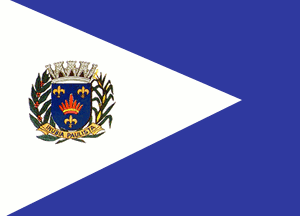 image by Dirk Schönberger,
11 November 2012
image by Dirk Schönberger,
11 November 2012Source: http://www.inubiapaulista.sp.gov.br/_portal/simbolos/ver.asp?id=2

Last modified: 2012-12-09 by ian macdonald
Keywords: sao paulo | inúbia paulista |
Links: FOTW homepage |
search |
disclaimer and copyright |
write us |
mirrors
 image by Dirk Schönberger,
11 November 2012
image by Dirk Schönberger,
11 November 2012
Source:
http://www.inubiapaulista.sp.gov.br/_portal/simbolos/ver.asp?id=2
A blue flag with a white triangle extending from the hoist about 75% of the length of the flag, bearing the municipal arms.
Official website at
http://www.inubiapaulista.sp.gov.br
Dirk Schönberger,
11 November 2012
Inúbia Paulista was settled in the 1940s by the Japanese colonists Kana Uejo, Assanu Tanabe, Sedo Otani and Kenji Muramatsu, subsequently joined by Italian, Portuguese and Spanish immigrants. The district of Ibirapuera was established, as part of the municipality of Lucélia, on 24 December 1948 by Decree Law No. 233 and inaugurated on 1 January 1949. Further colonization was facilitated by the inauguration of the railway station on 20 April 1950. The municipality of Inúbia Paulista was established on 18 February 1959 by Decree Law No. 5,282 and inaugurated on 1 January 1960. The place was renamed for the Tupi-Guarani word "nhumni'a", "nhomby'a", a trumpet, most often made of a gourd, used in fighting and festivals; it is said that the early colonists found a lot of such tools.
The symbols of Inúbia Paulista are prescribed by Municipal Law no. 304, adopted on 2 September 1976.
The flag is blue with an isosceles triangle placed along the hoist and charged with the municipal coat of arms. The dimensions of the flag are 14 units x 20 units. The width of the triangle is 16.5 units. The height of the coat of arms is 6 units.
Photos (clickable) of the flag:
http://www.inubiapaulista.sp.gov.br/_portal/noticias/ver.asp?id=458
- 26 August 2011
http://www.inubiapaulista.sp.gov.br/_portal/noticias/ver.asp?id=195
- 23 July 2010
The coat of arms, designed by Lauro Ribeiro Escobar, is an "Iberic shield, azure a 'canitar' [native headdress?] proper surrounded by three fleurs-de-lis or. The shield surmounted by an eight-towered mural crown argent ports sable. The shield supported dexter by a branch of coffee leaved and fructed proper and sinister by a plant of maize leaved and fructed proper. Below the shield a scroll or charged with the toponym 'INUBIA PAULISTA' in letters azure."
The Iberic shield, used in Portugal at the time of the discovery of Brazil, evokes the early colonizers and builders of the country. Azure (blue) is a symbol of justice, beauty, sweetness, nobleness, vigilance, serenity, constancy, incorruptible firmness, dignity, zeal and loyalty. The "canitar" recalls that the site of today's Inúbia Paulista was originally a native dwelling, of which several archaeological remain have been found. It also means force, independence, liberty an authenticity. The fleur-de-lis is a symbol of the Blessed Virgin, representing here the town's patron saint, Our Lady of the Immaculate Conception and the protection she offers to the believers. Or is a symbol of wealth, splendour, glory, nobleness, power, force, faith, prosperity, sovereignty and rule. The mural crown is a symbol of political emancipation. The ports sable are a symbol of hospitality. The coffee branch and the maize plant represent the fertility of the soil and important crops contributing to the progress of the municipality, of the State and of the country.
http://www.camarainubiapaulista.sp.gov.br/_portal/simbolos/ver.asp?id=1 - Municipal website
Ivan Sache, 13 November 2012